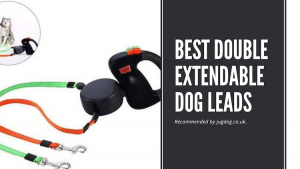Being outdoors with your pooch should be one of life’s great pleasures. Sadly, this isn’t always the case because some dogs dislike being on a lead. You could argue that they might need more training, but that’s what we’re diving into today.
Slip leads are somewhat controversial, leading to many people asking online if using one is cruel to their pets.
I’ll explain the matter in detail, starting with what slip leads are and their intended uses. But if you’re in a hurry, here’s the quick answer:
Slip leads are not necessarily cruel to dogs but harmful when used improperly. They have a positive effect on trained dogs. However, an untrained dog that doesn’t know to stop pulling on the lead might get choked. You should use them cautiously and consult a vet before using them on your dog.
Cruelty is defined as “behaviour which causes physical or mental harm to another, whether intentionally or not”. Of course, it’s a bit subjective when taken in the context of dogs.
For example, some people believe crate training is unfair, whereas others (including me) have found that, ultimately, it was the best option to housebreak our dog.
So, to avoid confusion, I’ll focus on the impact of slip leads on a dog. Do they physically or mentally harm them? You can decide on cruelty based on these facts.
What is a slip lead? Does it cause pain?
Slip leads are training leads to keep our four-legged friends at a safe distance. A thick rope tightens around the dog’s neck as it pulls away.
Some would say the contraption is a leash and a collar (see also ‘How To Train Your Puppy To Wear A Collar‘) all in one.
They are designed to be slack most of the time and only get tighter when needed to stop the dog from piling into dangerous situations.
Generally, slip leads are suitable for well-trained dogs as their effectiveness varies among breeds, sizes, and temperaments. Dogs or puppies with a tendency to pull or exhibit strong prey drive might not respond as positively to slip leads. Smaller or more delicate breeds may be more susceptible to injury when using slip leads.
1. Pros vs Cons of Using a Slip Lead
| Aspect | Pros | Cons |
| Effectiveness | Quick control for trained dogs | Less effective for untrained or strong-willed dogs |
| Quick Release | Immediate correction and release | Can encourage pulling if used improperly |
| Temporary Control | Useful for quick restraint in various settings | Risk of injury if not used gently |
| Risk of Injury | Minimal when used correctly | High risk for untrained dogs and small breeds |
| Training Impact | Positive reinforcement for trained dogs | Potential behavioural issues for untrained dogs |
Pros of Using Slip Leads:
Slip leads have distinct advantages in specific situations. For dogs already trained and responsive to commands, slip leads can offer swift control, especially during walks or transitioning between locations.
Their quick-release mechanism allows for immediate correction and release, promoting timely positive reinforcement. Slip leads can be particularly useful during veterinary visits or when quick and controlled restraint is needed.
Cons of Using Slip Leads:
The risk of injury is a primary concern, especially if used on untrained dogs or those that tend to pull aggressively. If used incorrectly, the tightening mechanism can cause discomfort, pain, or choking.
Slip leads may inadvertently encourage pulling behaviour in untrained dogs as they learn to resist the sensation of the lead tightening around their necks.
Unfortunately, improper use can lead to behavioural issues, as dogs might associate discomfort with certain environments or experiences.
2. How to properly put on a slip lead?
Step 1: Adjust the loop size.
It should be large enough to fit comfortably over your dog’s head without causing any sudden movements or startling reactions.
Step 2: Position it properly.
Place the slip lead around their neck, positioning it behind their ears and over their jaw. This placement ensures that the pressure is distributed across the neck rather than concentrated on the throat area.
Step 3: Maintain proper gap.
You can easily achieve this by placing two fingers – usually your index and middle fingers – between the neck and the lead. This gap allows for comfortable movement and prevents the lead from tightening too closely.
Remember, proper placement and adjustments are essential. Rushing through this process can lead to your dog associating the lead with discomfort or negative experiences.
3. Training and Proper Use
Using a slip lead effectively requires proper placement and appropriate training. Here’s how to train your dog to properly use a slip lead:
- If your dog is new to a slip lead, introduce it gradually. Allow them to sniff and inspect the lead before putting it on.
- Associate the slip lead with positive experiences. Reward your dog with treats, praise, and gentle pets whenever you put the lead on.
- Begin practising indoors in a controlled environment. Gently guide your dog with the slip lead and avoid sudden movements.
- Use the slip lead for gentle corrections when walking outdoors. If your dog starts to pull, apply a slight tug to remind them to stay close. Always maintain a loose lead when your dog is walking calmly.
- Consistency is key to successful training. Use the slip lead consistently during walks and training sessions. Be patient and avoid excessive force.
Conclusion: Should I use a slip lead on my dog?
Yep, absolutely.
Slip leads are an ideal choice for fully trained pooches who are amazing on a lead, as it will always be slack, and only some material is on them. Training a dog to not pull can arguably be done quicker as your dog will quickly learn it is not worth it.
Slip leads are highly durable and generally thicker than tape, cord or leather leads, so owners of lead chewers won’t have to replace them as often. However, this won’t teach them to chew the lead, so their effectiveness is debatable.
Alternative Tools and Techniques
While slip leads have their place in certain situations, it’s important to explore alternative tools and techniques that can achieve similar goals without potential drawbacks.
1. Front-Clip Harness: It attaches to the front of your dog’s chest, redirecting their forward movement when they pull. This encourages them to walk beside you and reduces the risk of neck strain or discomfort.
2. Martingale Collar: Similar to a slip lead, it tightens when a dog pulls, but it limits how tight it can become. This prevents over-tightening and potential injury.
3. Head Collar: A head collar, such as the Gentle Leader or Halti, fits around your dog’s muzzle and controls its head movements.
4. Back-Clip Harness: It attaches to your dog’s back and is ideal for dogs that don’t pull excessively. It allows for a more relaxed walking experience while reducing pressure on the neck.
Each dog is unique, and their training needs vary. Consider your dog’s size, breed, behaviour, and comfort when choosing an alternative tool or technique.
Consulting a professional dog trainer can provide valuable insights tailored to your dog’s needs.
Frequently Asked Questions (FAQs)
1. Is it wrong to use a slip lead?
Unless your dog is highly trained on a lead, using a slip lead over a regular lead may be wrong or cruel. Alternatively, if you take the time to properly train your dog, the benefits of using a slip lead far outweigh the cons.
2. Can slip leads contribute to behavioural issues in dogs?
Slip leads can contribute to behavioural issues if used incorrectly or on untrained dogs. Dogs might associate discomfort with the lead, leading to fear or resistance. Proper training and gentle usage are crucial to prevent negative behavioural outcomes.
3. Do slip leads help reactive dogs?
Generally speaking, slip leads might not be the best choice for reactive dogs. Their sudden tightening can trigger anxiety or aggression. Consider alternative tools like front-clip harnesses or head collars that provide better control without causing stress.
4. Should I consult a professional trainer before using a slip lead?
Consulting a professional trainer is highly recommended before using a slip lead, especially if you’re uncertain about its proper use or your dog’s reaction. A trainer can guide you on the right techniques and alternatives tailored to your dog’s needs.
5. Can a slip lead damage a puppy?
Slip leads can potentially harm puppies due to their delicate necks and developing bodies. It’s best to avoid using slip leads on puppies and opt for safer alternatives like harnesses that distribute pressure more evenly.
6. Why do vets use slip leads?
Vets often use slip leads for quick restraint during medical procedures. Their familiarity with handling dogs and ensuring correct usage prevents harm. However, using slip leads at home requires proper training and care.





Tell me what the difference is between a leash and a collar and a slip lead, absolutely nothing when the dog is pulling, only difference is a collar is always tighter around the neck of a dog to start with, so what’s crueller. As for a harness, they only encourage a dog to pull to start with.
A sliplead won’t insure a dog if it’s correctly fitted and secured behind the skull.The issue is no slip lead stays in place properly and this is when injuries occur.
I get confused. My dog pulls and unfortunately I’ve not got a good solution (I recognise it is me at fault as the owner). I’m thinking of getting a slip lead but also taking the other lead out as well.